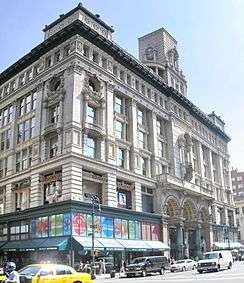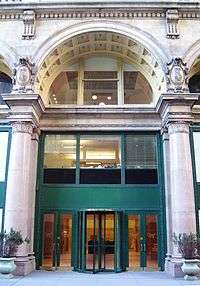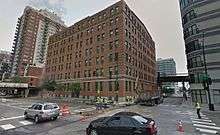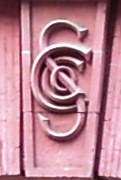Siegel-Cooper Company
The Siegel-Cooper Company was a department store that opened in Chicago in 1887 and expanded into New York City in 1896. At the time of its opening, the New York store was the largest in the world.
| Department Store | |
| Industry | Store |
| Founded | 1887 |
| Founder | Henry Siegel Frank H. Cooper Isaac Keim |
Area served | Chicago, New York City, Boston |




First store in Chicago
Siegel-Cooper began as a discount department store on State Street in the Loop. It was founded by Henry Siegel, Frank H. Cooper and Isaac Keim in 1887. Four years later, the store moved into the eight-story Second Leiter Building at State and Van Buren Street, designed by William Le Baron Jenney, where it stayed until 1930, after a 1914-15 reorganization into Associated Dry Goods Corp., but keeping the Siegel-Cooper name in Chicago.[1] The building was then occupied from 1931 to 1986 by Sears, Roebuck & Company. It continues in use, most recently in the 21st century as a college campus.
Second store in New York City
In September 1896,[2][3]:8 the company opened a store in New York City, a huge emporium in the Ladies' Mile Shopping District, joining the other major department stores in the neighborhood. Their steel-framed building, the first department store in New York to be so constructed, was the largest store in the world at the time, and was designed in Beaux-Arts style by DeLemos & Cordes, who would go on to design the R. H. Macy's store in Herald Square, which then took the title of largest. The six-story Siegel-Cooper store was located at 616-632 Sixth Avenue between West 18th and 19th Streets, and was built between 1895 and 1897, then expanded in 1899.[4]
The steel-framed construction of the "Big Store", as it was called at the time, enabled the building to have large interior spaces with uninterrupted selling floors, and allowed for skylit courts.[3]:17 Siegel-Cooper took full advantage of the novelty – to New York City – of steel-framing by advertising the building as "the only and absolutely fire-proof and perfectly safe store in New York City."[3]:330
The store offered a wide variety of dry goods in its 18 acres (7 ha.), as well as other amenities such as a grocery department, barber shop, theatre, telegraph office, art gallery, photo studio, bank, dental office, a 350-person restaurant, and a conservatory which sold live plants. The main floor featured a copy of Daniel Chester French's statue The Republic[5] inside a marble-enclosed fountain. This was a popular meeting place, giving rise to the phrase "Meet me at the fountain," which the store used as a slogan,[2][4] along with "A City in Itself" and "Everything Under the Sun".[3]:331
At its peak, the store employed over 3,000 people, mostly girls and women, and offered its employees an infirmary, a parlor and a gymnasium.[4] The company also published a newspaper for its workers, called Thought and Work.[2]
Third store in Boston
In 1905, The Henry Siegel Company opened a large store in Boston, at 600 Washington Street.[6] The Boston store was converted into an office building and a movie theater in 1915. The light court on Washington Street was infilled in the 1970s, and the theater closed in the 1990s. The building was further modified to create a new entrance to the MBTA Orange Line Chinatown station in 2004. The building is now home to Commonwealth of Massachusetts offices and small retailers. The fate of the disused theater is undecided.
Decline, closing and renewal
In 1902, Henry Siegel sold the company to one of his major stockholders, Captain Joseph B. Greenhut and his son Benedict J. Greenhut, who merged the store with B. Altman across the street in New York City,[3]:331 creating a mega-store which was ultimately unsuccessful.[4] In 1913–14 J.P. Morgan was involved in combining the company with other retailers as the Associated Dry Goods Corp.[1] Siegel-Cooper declared bankruptcy in 1915,[2] and the New York store closed in 1917, becoming a military hospital during World War I[7] and then a warehouse.[4]
The Chicago store closed around 1930, and that building was taken over by Sears, Roebuck as their flagship store in 1931.[1] In the 21st century, it is the Chicago campus of Robert Morris University Illinois.
After decades of miscellaneous use as a warehouse, the NBC Television scene shop and the location "The Door", a social services center, the New York building become one of the first of the great dry-goods emporia in the Ladies' Mile to be renovated and re-opened for retail use. Calling itself "The Anchor of the Avenue", the building's retail tenants currently are Bed, Bath & Beyond, T.J. Maxx and Marshall's.

See also
References
- "Siegel, Cooper & Co". Encyclopedia of Chicago. Retrieved February 15, 2011.
- Abelson, Elaine S. "Siegel-Cooper" in Jackson, Kenneth T., ed. (2010). The Encyclopedia of New York City (2nd ed.). New Haven: Yale University Press. ISBN 978-0-300-11465-2., p.1182
- Ladies' Mile Historic Designation Report (PDF). New York City Landmarks Preservation Commission. 1st. 1989. Archived from the original (PDF) on 2011-06-28. Retrieved 2011-02-16.
- Mendelsohn, Joyce (1998), Touring the Flatiron: Walks in Four Historic Neighborhoods, New York: New York Landmarks Conservancy, ISBN 0-964-7061-2-1, OCLC 40227695, pp.90-92
- The statue is now at Forest Lawn Cemetery. White, Norval & Willensky, Elliot (2000). AIA Guide to New York City (4th ed.). New York: Three Rivers Press. ISBN 978-0-8129-3107-5., pp.191-192
- "Siegel Bankruptcy Schedules Filed". The Boston Globe. 7 Feb 1914. p. 13.
- White, Norval & Willensky, Elliot (2000). AIA Guide to New York City (4th ed.). New York: Three Rivers Press. ISBN 978-0-8129-3107-5., pp.191-192
External links
| Wikimedia Commons has media related to Siegel-Cooper. |
- Advertising fan for the Siegel Cooper Co. store in New York (1899) on the Staten Island Historical Society Online Collections Database